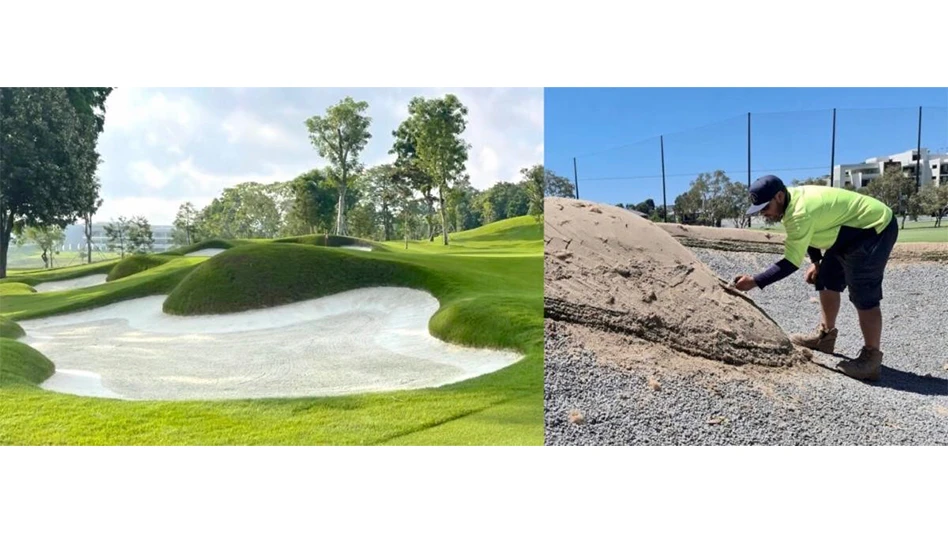
Nothing against Major Season, but admit it, deep down inside superintendents have an aversion to springtime. Why? Because it’s tournament time, which means the majors are on television.
While it’s educational and a career benefit to volunteer or even spectate at these events, most of us are likelier to watch majors on television. What can we learn from what we see on TV?
Putting Greens. As you watch the action, look for surface moisture stress, and where it is located. Even at the highest levels of conditioning, stress can be visible at a green’s entry and exit points, on surfaces facing the sun and in the wind pattern zones. Same for your greens.
You rarely see the scalping of old holes or frayed edges during a broadcast. The precision of placing a hole location will make a huge impression, especially for shorter putts from shaky hands. Avoid placing a new hole near an old plug.
Hole locations are an area where big tournaments should not be the standard for your clubs. Most members aren’t good enough to deal with putts to the toughest locations, so all you’re doing is frustrating them and slowing play.
That said, altering hole locations is an easy way to throw a change-up at your regulars. Don’t fall into the habit of constantly going to the same three or four locations round after round.
Note how courses are set up to complement the weather. When wet, no holes in bowls; when dry, no holes on top of hills. On windy days, no front hole locations, as they are the most difficult to attack and the hardest to approach.
Don’t place hole locations near bunkers on par 3s as players don’t like to see excessive sand on surfaces or too close to the hole. Avoid most hole locations and any other spot where a player must hit over a bunker to get onto the green. And on busy days, especially weekends, go easy on where the holes are cut. Keep golfers happy and keep them moving.
Finally, the same basic idea applies to green speeds: Keep heights-of-cut and green speeds under control. Once the correct green speed or cutting heights are lost, you cannot get them back.
Teeing Grounds. Watch whenever a professional is on the tee and the camera angle is right behind them. Notice how tee markers are angled in the right direction and toward the intended target. These players are good enough not to let out-of-whack tee alignment bother them; your players aren’t. Don’t point them to trouble.
Keep teeing areas firm with a height-of-cut at least 0.300. If too short, they’re going to slip and blame you for a bad tee shot.
Do you give any thought to the mowing pattern on the tee? Tournaments do. Those tees are cut either from 6 o’clock to 12, a shadow cut (light and dark), or in one direction. I prefer the left-to-right method to throw the tournament player a curve. Don’t play visual tricks on your players. Let the teeing area help them.
Notice how far apart the tee markers are. Seven solid paces are the preferred width as long as there’s enough width on the tee.
Fairways. Here’s a lesson all superintendents at televised courses have learned: The lower you cut, the more flaws and blemishes become visible. Be careful when cutting around irrigation heads and drains; mistakes there not only look bad but can also ding mowers and knock equipment out of alignment.
Personally, I hate to see too much bounce and roll on TV, the result of low heights of cut. The pros certainly don’t need any extra length. I don’t think your golfers do, either—hey, it’s a game that’s played outdoors — but this is one condition you can have some control over. Your golfers will want some roll, but don’t make it too easy on them.
And over-striping fairways is strictly for TV cameras. It’s rarely necessary at your course.
Bunkers. If you are using mechanical bunker rakes — one for the front and one for the back — make sure the teeth are the same length to ensure consistent conditions.
Resist tight turns and excessive speed to reduce tire tracking and sand ridges where a club can touch the sand in a backswing.
You already know which bunkers on your course get the most play. Avoid placing a hole location close to those culprits, especially on busy days.
Rough. Like bunkers, the disparity between pro play and amateur play out of long grass is huge. It’s unlikely you need to hand rake or backpack blow rough or incorporate wild mowing patterns, so it stands up, unless you’re prepping for a big event. For rough preparation, the diameter of a golf ball — 1.68 inches — is adequate and don’t let it grow any more than 2.25 inches, depending on your equipment and time of year.

Explore the April 2025 Issue
Check out more from this issue and find your next story to read.
Latest from Golf Course Industry
- Toro continues support of National Mayor’s Challenge for Water Conservation
- A different kind of long distance
- Golf Construction Conversations: Stephen Hope
- EnP welcomes new sales manager
- DLF opening centers in Oregon, Ontario
- Buffalo Turbine unveils battery-powered debris blower
- Beyond the Page 66: Keep looking up
- SePRO hires new technical specialist





